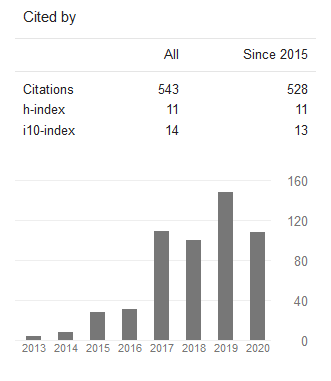Prediksi Parasit Plasmodium pada Citra Mikroskopis Sel Darah Merah dengan Convolutional Neural Networks
DOI:
https://doi.org/10.24002/jbi.v13i1.5007Abstract
Abstract. Prediction of Plasmodium Parasites on Microscopic Image of Red Blood Cells with Convolutional Neural Networks. Malaria is a deadly disease that attacks human blood cells caused by the plasmodium parasite. The need for fast and accurate detection in the diagnosis of malaria is certainly necessary to reduce the mortality rate from this disease. The technique for detecting the presence of Plasmodium parasites that has been widely used in routine examinations is using a microscope. With the presence of experienced medical experts, it is easy to detect the presence of Plasmodium in the blood. However, the weakness of this technique is that it relies heavily on the presence and competence of medical experts because the accuracy of microscopic examination results can decrease from 64% to 95%. The purpose of this study was to build a predictive model to classify Plasmodium parasites on red blood cell images with a good degree of accuracy with the Convolutional Neural Network algorithm. The test results show good accuracy results, namely the model of the CNN Algorithm gives an accuracy result of 97.96% and a loss of 0.06 with an average computation time of about 121 seconds/epoch.
Keywords: malaria, optimization, Plasmodium, neural network, CNN.
Abstrak.Malaria merupakan salah satu penyakit mematikan yang menyerang sel darah manusia yang disebabkan parasit plasmodium. Kebutuhan deteksi cepat dan akurat dalam diagnosis malaria tentunya sangat diperlukan untuk menekan angka kematian dari penyakit ini. Teknik deteksi keberadaan parasit Plasmodium yang telah banyak digunakan dalam pemeriksaan rutin adalah dengan menggunakan mikroskop. Dengan adanya tenaga
ahli medis yang berpengalaman, pendeteksian keberadaan Plasmodium dalam darah pun dengan mudah dilakukan. Namun kelemahan dari teknik ini adalah sangat bergantung pada keberadaan dan kompetensi dari tenaga ahli medis karena akurasi dari hasil pemeriksaan mikroskop dapat menurun 64% sampai dengan 95%. Tujuan penelitian ini adalah membangun sebuah model prediksi untuk mengklasifikasikan parasit plasmodium
pada citra sel darah merah dengan tingkat akurasi yang baik dengan algoritma Convolutional Neural Network. Hasil pengujian memperlihatkan hasil akurasi yang baik yaitu model dari Algoritma CNN ini memberikan hasil akurasi yaitu 97,96% dan loss 0,06 dengan rata-rata waktu komputasi sekitar 121 detik/epoch.
Kata kunci: malaria, deep learning, Plasmodium, neural network, CNN.
References
World Health Organization. Malaria Rapid Diagnostic Test Performance: Executive Summary. WHO. 2020.
World Health Organization, Basic Malaria Microscope. Part1. Learner’s Guide, 2nd ed., Geneva: WHO. 2010. ISBN: 9241547820. Pp. 7-12.
World Health Organization. Diagnosis of malaria. Guidelines for the treatment of malaria. Second edition. World Health Organization 2012. ISBN 978 92 4 154792 5. pp. 10-12.
Massamba, J.E., Djontu, J.C., Vouvoungui, C.J. et al. Plasmodium falciparum multiplicity of infection and pregnancy outcomes in Congolese women from southern Brazzaville, Republic of Congo. Malar J 21, 114 (2022). https://doi.org/10.1186/s12936-022-04105-w
DIMI, B., ADAM, A., ALIM, A. Prevalensi Malaria Berdasarkan Karakteristik Sosio Demografi. Jurnal Ilmiah Kesehatan. Vol. 19 No. 1. 2020. p-ISSN: 1412-2804. DOI: 10.33221/jikes.v19i01.399.
Centers for Disease Control and Prevention. Malaria. CDC. Web. 10 May 2022. <http://www.cdc.gov/dpdx/malaria/index.html>
LIU, D., JIANYU. Otsu Method and K-means. International Conference on Hybrid Intelligent Systems. Department of Computer Science Beijing Jiaotong University Beijing. IEEE. China. 2009. ISBN 978-0-7695-3745-0. pp. 344-349.
GATC, J., et al. Plasmodium Parasite Detection on Red Blood Cell Image for the Diagnosis of Malaria Using Double Thresholding. ICACSIS: IEEE. 2013. pp. 236-240.
GATC, J., MASPIYANTI, F. Red blood cell and white blood cell classification using double thresholding and BLOB analysis. IEEE 4th International Conference on Information and Communication Technology (ICoICT). 2016. ISBN: 978-1-4673-9879-4. pp. 1-5.
MASPIYANTY, F., GATC, J. Plasmodium Falciparum Stages Classification on Red Blood Cell Image using Region Property. IEEE 1st International Conference on Information Technology, Information Systems and Electrical Engineering. 2016. ISBN 978-1-5090-1567-2. pp. 105-109.
ANGGRAINI, D., et.al. Automatic Status Identification of Microscopic Images Obtained from Malaria Thin Blood Smears. Proc. of 3rd International Conference on Electrical Engineering and Informatics (ICEEI 2011), CDROM A3-2. Institut Teknologi Bandung. Bandung, Indonesia. 2011. pp. 347-352.
JAEGER, S., Malaria Dataset: NIAID. National Library of Medicine. Lister Hill National Center for Biomedical Communication. 2019. https://doi.org/10.7717/peerj.6977.
BORAY, F., et. al. Parasite detection and identification for automated thin blood film malaria diagnosis. Computer Vision and Image Understanding. Elsevier. 2011. pp. 89-95.
ROMANI, L., PANE, S., SEVERINI, C. et al. Challenging diagnosis of congenital malaria in non-endemic areas. Malar J 17, 470 (2018). https://doi.org/10.1186/s12936-018-2614-9.
RAHNAMATAN, Z., MOHAMAND, S., Tissue Segmentation in Medical Images Based on Image Processing Chain Optimization. International Workshop on Real Time Measurement, Instrumentation & Control (RTMIC), IEEE NPSS. Toronto. 2010. pp. 697-703.
Mehedi Masud, Hesham Alhumyani, Sultan S. Alshamrani, Omar Cheikhrouhou, Saleh Ibrahim, Ghulam Muhammad, M. Shamim Hossain, Mohammad Shorfuzzaman, "Leveraging Deep Learning Techniques for Malaria Parasite Detection Using Mobile Application", Wireless Communications and Mobile Computing, vol. 2020, Article ID
, 15 pages, 2020. https://doi.org/10.1155/2020/8895429
ZHANG, Y., LOBO-MUELLER, E.M., KARANICOLAS, P. et al. CNN-based survival model for pancreatic ductal adenocarcinoma in medical imaging. BMC Med Imaging 20, 11 (2020). https://doi.org/10.1186/s12880-020-0418-1
REUTERSWÄRD, P., BERGSTRÖM, S., ORIKIIRIZA, J. et al. Levels of human proteins in plasma associated with acute paediatric malaria. Malar J 17, 426 (2018). https://doi.org/10.1186/s12936-018-2576-y
QUAKYI, I.A., ADJEI, G.O., SULLIVAN, D.J. et al. Diagnostic capacity, and predictive values of rapid diagnostic tests for accurate diagnosis of Plasmodium falciparum in febrile children in Asante-Akim, Ghana. Malar J 17, 468 (2018).
https://doi.org/10.1186/s12936-018-2613-x
TANNER, M., et.al. Malaria eradication: benefits, future scenarios and feasibility: Executive summary. World Health Organization. 2019.
Fuhad KMF, Tuba JF, Sarker MRA, Momen S, Mohammed N, Rahman T. Deep Learning Based Automatic Malaria Parasite Detection from Blood Smear and its Smartphone Based Application. Diagnostics (Basel). 2020;10(5):329. Published 2020 May 20. doi:10.3390/diagnostics10050329.
Downloads
Published
Issue
Section
License
Copyright (c) 2022 Jurnal Buana Informatika

This work is licensed under a Creative Commons Attribution-ShareAlike 4.0 International License.
Copyright of this journal is assigned to Jurnal Buana Informatika as the journal publisher by the knowledge of author, whilst the moral right of the publication belongs to author. Every printed and electronic publications are open access for educational purposes, research, and library. The editorial board is not responsible for copyright violation to the other than them aims mentioned before. The reproduction of any part of this journal (printed or online) will be allowed only with a written permission from Jurnal Buana Informatika.
This work is licensed under a Creative Commons Attribution-ShareAlike 4.0 International License.










